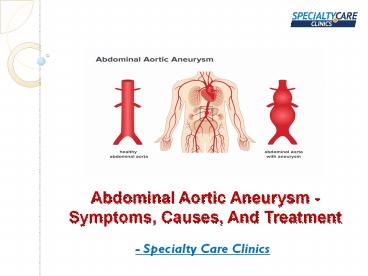Abdominal Aortic Aneurysm - Symptoms, Causes, and Treatment - PowerPoint PPT Presentation
Title:
Abdominal Aortic Aneurysm - Symptoms, Causes, and Treatment
Description:
Abdominal Aortic Aneurysm is one of the deadliest diseases for which treatment is needed immediately. This article gives you information about symptoms, causes, diagnosis and treatment options available for this disease. – PowerPoint PPT presentation
Number of Views:275
Title: Abdominal Aortic Aneurysm - Symptoms, Causes, and Treatment
1
Abdominal Aortic Aneurysm - Symptoms, Causes, And
Treatment
- - Specialty Care Clinics
2
What is an Abdominal Aortic Aneurysm?
- An abdominal aortic aneurysm (AAA) is a swollen
region in the lower part of the important vessel
that supplies blood to the body (aorta). The
aorta runs from your heart through the center of
your chest and stomach. - The aorta is the biggest blood vessel in the
body, so a ruptured abdominal aortic aneurysm
could cause life-threatening bleeding. - Depending upon the size of the aneurysm and how
fast it is growing, treatment varies from
watchful waiting to emergency surgery.
3
Abdominal Aortic Aneurysm Symptoms
- Abdominal aortic aneurysms usually grow gradually
without symptoms, making them hard to detect.
There are aneurysms that never rupture. Many
start small and stay small others expand over
time, some rapidly. - If you have an enlarging abdominal aortic
aneurysm, you may notice - Deep, continuous pain in your abdomen or on
the side of your abdomen - Back pain
- A pulse near your bellybutton
4
Abdominal Aortic Aneurysm Causes
- Aneurysms could develop anywhere along the aorta,
but most aortic aneurysms happen in the part of
your aorta that is in your abdomen. A number of
factors could play a role in developing an aortic
aneurysm, including - Hardening of the arteries (atherosclerosis) -
Atherosclerosis happens when fat and other
substances accumulate on the lining of a blood
vessel. - High blood pressure - High blood pressure
could damage and weaken the aorta's walls. - Blood vessel diseases - These are diseases
that cause blood vessels to become swollen. - Infection in the aorta - Rarely, a bacterial
or fungal infection may cause abdominal aortic
aneurysms. - Get More Details Information Click Here
5
Contact Us
- Website https//specialtycareclinics.com/
- Contact No. 469-545-9983
- Email hugosutton020_at_gmail.com
6
Thank You

